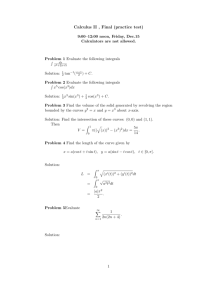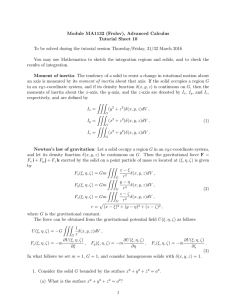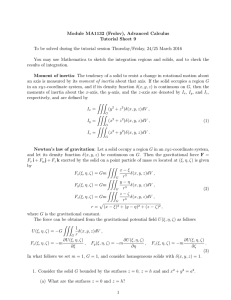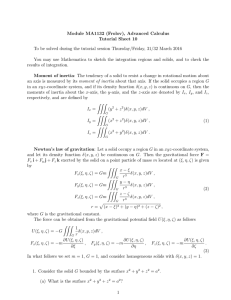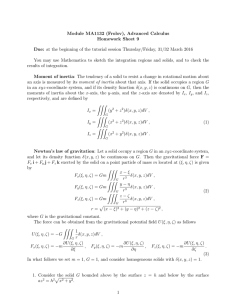Module MA1132 (Frolov), Advanced Calculus Homework Sheet 10
advertisement
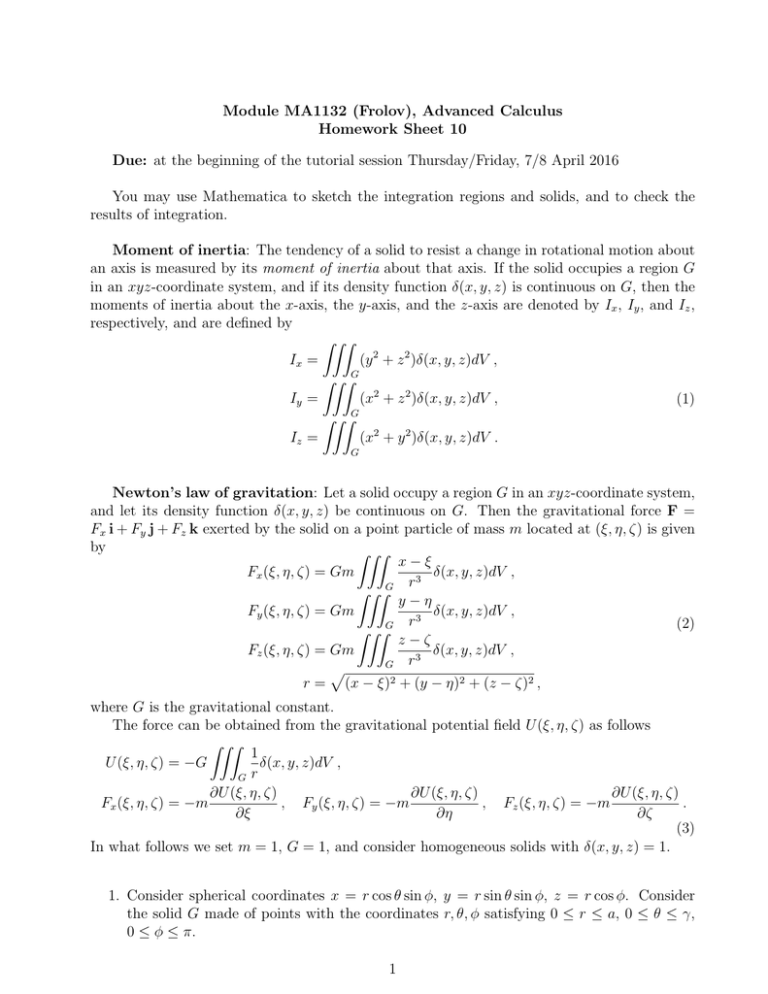
Module MA1132 (Frolov), Advanced Calculus Homework Sheet 10 Due: at the beginning of the tutorial session Thursday/Friday, 7/8 April 2016 You may use Mathematica to sketch the integration regions and solids, and to check the results of integration. Moment of inertia: The tendency of a solid to resist a change in rotational motion about an axis is measured by its moment of inertia about that axis. If the solid occupies a region G in an xyz-coordinate system, and if its density function δ(x, y, z) is continuous on G, then the moments of inertia about the x-axis, the y-axis, and the z-axis are denoted by Ix , Iy , and Iz , respectively, and are defined by ZZZ Ix = (y 2 + z 2 )δ(x, y, z)dV , Z Z ZG (x2 + z 2 )δ(x, y, z)dV , Iy = (1) G ZZZ Iz = (x2 + y 2 )δ(x, y, z)dV . G Newton’s law of gravitation: Let a solid occupy a region G in an xyz-coordinate system, and let its density function δ(x, y, z) be continuous on G. Then the gravitational force F = Fx i + Fy j + Fz k exerted by the solid on a point particle of mass m located at (ξ, η, ζ) is given by ZZZ x−ξ Fx (ξ, η, ζ) = Gm δ(x, y, z)dV , r3 G ZZZ y−η δ(x, y, z)dV , Fy (ξ, η, ζ) = Gm r3 (2) G ZZZ z−ζ Fz (ξ, η, ζ) = Gm δ(x, y, z)dV , 3 G r p r = (x − ξ)2 + (y − η)2 + (z − ζ)2 , where G is the gravitational constant. The force can be obtained from the gravitational potential field U (ξ, η, ζ) as follows ZZZ 1 U (ξ, η, ζ) = −G δ(x, y, z)dV , G r ∂U (ξ, η, ζ) ∂U (ξ, η, ζ) ∂U (ξ, η, ζ) Fx (ξ, η, ζ) = −m , Fy (ξ, η, ζ) = −m , Fz (ξ, η, ζ) = −m . ∂ξ ∂η ∂ζ (3) In what follows we set m = 1, G = 1, and consider homogeneous solids with δ(x, y, z) = 1. 1. Consider spherical coordinates x = r cos θ sin φ, y = r sin θ sin φ, z = r cos φ. Consider the solid G made of points with the coordinates r, θ, φ satisfying 0 ≤ r ≤ a, 0 ≤ θ ≤ γ, 0 ≤ φ ≤ π. 1 (a) What is the surface r = a? (b) What are the surfaces θ = 0 and θ = γ? (c) What are the sets of points φ = 0 and φ = π? (d) Sketch and describe the solid G and its projection onto the xy-plane. (e) Find the volume V of the solid G. Specify your answer for γ = π and γ = 2π and explain the result. (f) Find the centroid of the solid G. Specify your answer for γ = π and γ = 2π. (g) Find the moments of inertia of the solid G. Specify your answer for γ = π and γ = 2π. (h) Set γ = π, and find the gravitational force exerted on a point particle by the solid G if the point particle is located at (0, ζ, 0). To simplify the computation introduce different spherical coordinates by exchanging y and z. Why does it simplify the computation? (i) Set γ = π, and find the gravitational potential field U (0, ζ, 0) of the solid G. (j) Plot Fz (0, ζ, 0) and U (0, ζ, 0)) for γ = π and a = 1. Show the details of your work. 2. Consider the solid G that is generated by revolving the disc z 2 + (x − b)2 ≤ a2 , 0<a<b in the xz-plane about the z-axis. (a) What is the solid? (b) Show that this solid can be expressed parametrically as x = (b + ρ cos φ) cos θ , y = (b + ρ cos φ) sin θ , 0 ≤ ρ ≤ a , 0 ≤ θ ≤ 2π , 0 ≤ φ ≤ 2π . z = ρ sin φ , (c) Write the parametrisation of the boundary of this solid induced by (4). (d) Find the area of the boundary. (e) Think about (4) as a change go variable. Find the Jacobian of the change. (f) Find the volume V of the solid G. (g) Find the moments of inertia of the solid G. Show the details of your work. 3. Consider the solid G bounded by the “astroidal” hyperboloid of one sheet x 2/3 a + y 2/3 b and by the planes z = −c and z = c. 2 − z 2/3 c = 1, (4) (a) Plot the astroidal hyperboloid for a = b = c = 1. (b) G can be expressed parametrically by a generalisation of hyperbolic coordinates x = a r(cosh p cos θ)3 , 0 ≤ r ≤ 1, y = b r(cosh p sin θ)3 , z = c r sinh3 p , − sinh−1 1 ≤ p ≤ sinh−1 1 , 0 ≤ θ ≤ 2π , (5) where sinh−1 is the function inverse to sinh: sinh−1 (sinh x) = sinh(sinh−1 x) = x. Think about (5) as a change of variables. Find the Jacobian of the change. (c) Find the volume V of the solid G. (d) Use Mathematica to find the moments of inertia of the solid G. Show the details of your work. 3


